Zoom session with tutor dr Michele Whiting on Thursday 03/03/2022
The session will first focus on my Parallel Project, as well as ideas around the Critical Review.
Parallel Project
Sharing the screen my tutor asked me to talk about making of Fig 1 – Mycelium painting and then moved to Fig. 8. She wants to understand the making linked to the OCA EU group work as it became clear for her in looking at the making that I battle with the literal in the making. I am working with mycelium (a life force) but struggle to kick against it, she senses a push-pull in the works. I do have materials and have been looking at other artists and how they use materials. The materiality needs to come through the practice. We spent some time with Fig 1 where I later developed it into an imprint – this shows an exploration of the materiality. I understand the potential of more development here, as my tutor envisions at least ‘half a dozen” works to come out of this. It is almost as if I need permission to continue exploring and thinking of upscaling the work? The work I made after making Fig 8, could be seen as over-explaining itself. There is potential lies in the work on its own – there is this white structure which could be developed as a type of cellular structure, without the fungi behind it – and showing as a layer that we as humans share with the fungal world. I feel positive that I need to grab hold of this potential in work, and not stop when I get stuck in the literal. It could become a beautiful work and an exploration of the cellular layer. I do like to think about this material alliance I could develop. I think I understood it is about finding the relationship between the literal and the made objects or making. I do want to explore the relationship between smaller drawings and notation inside the work.
After the session my tutor shared a work of artist, Ben Woolfitt with me. I appreciate this to continue issues with above works. It is motivating and inspiring. The work below shows materials I have been contemplating to develop a painting, drawings, or objects. I do feel I need to do this and will add to my work of Part Four.
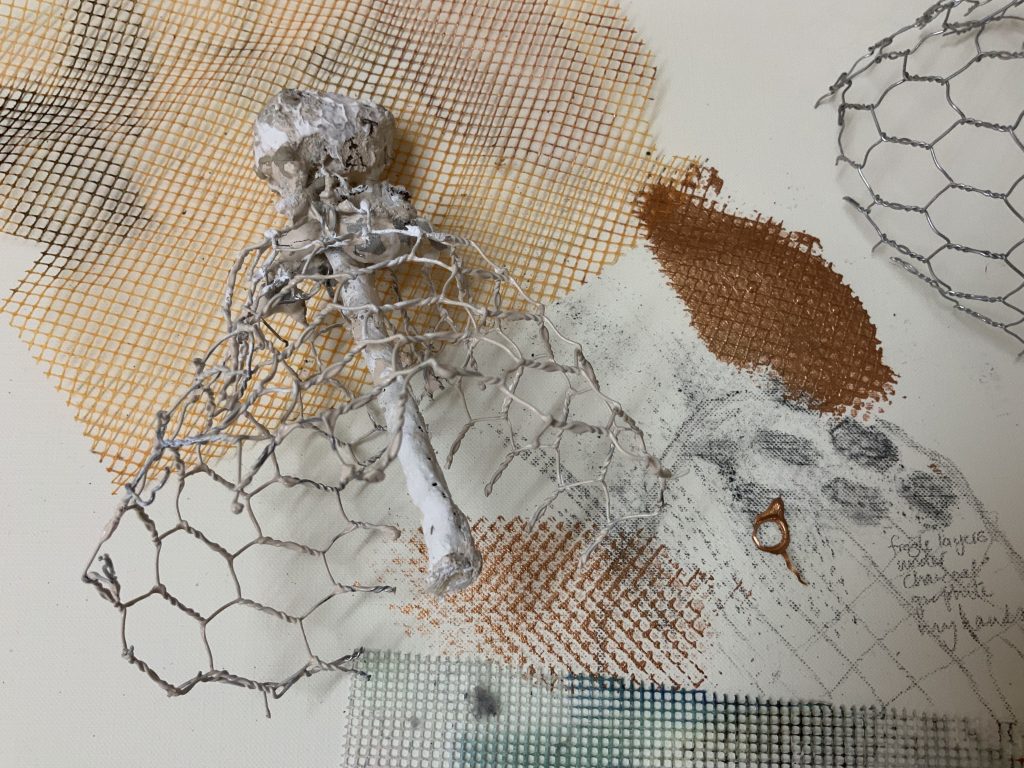
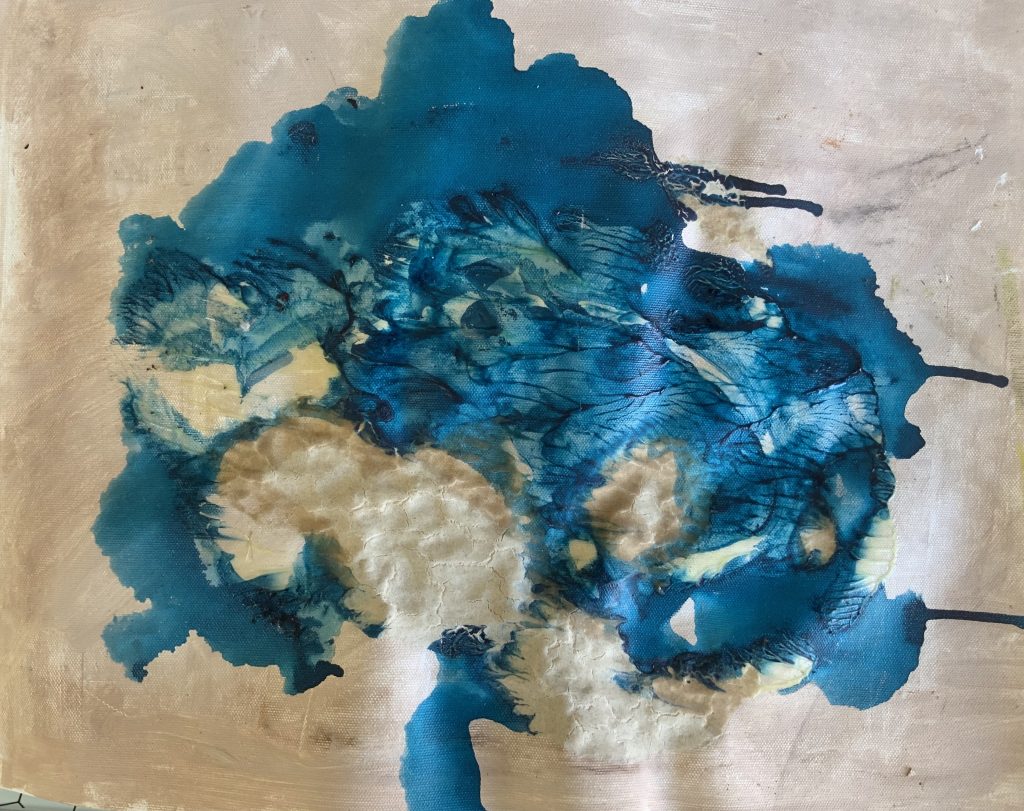
I consider my own insecurity – see it as a form of fear/insecurity. It could be an indication of being stuck – the choice is to skim the work, but knowing the rubicon has not been crossed – I am nearly there if allow time and studio work. It is assuring that this uncomfortable space is where most artitst find them – we have to talk and I appreciate this safe space with my tutor, which becomes very practical and shared – its a process of working trough – pushing trough, it is in this experience, studio time, that the real work can be and so much learning and enjoyment could be find.
The combined work is seen as good – recognizing kinships, meaning they have characteristic and shows my way of finding a way through the materials ( Blue mushroom, foil and blue mycelium like brushmarks) A bit of Cy Twombly can be seen – but the reflection is not capturing this. I should follow through with the relationship of the three things I put together. It is clear to my tutor that putting things together comes naturally in my making. I am thinking of scaling up and making a series. My tutor sees a strong visual research ability. We talk about notations that should come through – a way of finding out more. (Note to self: Look at this for use in part 5) We considered the object again – my relation to this and work I am making. It could be a group or just one object on its own. I am introduced to the work of Ian Kiaer in terms of how he uses the relationship between things, objects, painting, the language of paper, things. Each object has parity, – each is as important as the other – relationships can be seen, look at shadows – the proportions are thought about. My tutor suggest that in my mind, instead of separating things – they could all come together – have a conversation together. I should consider this, given that I have the ability to work with paint, with drawing, with smaller object. I can look at lots of his work as he has a good archive. I should look at the work of Ian Kiaer to research and learn from his use of the relationship of things. ( I will discuss below)
It is important that I stick to this advice as it is needed at this point – I really appreciate this nudge and openness in the discussion to look at my practice as a deliberate space where I make and continue to develop ideas and questions. In my case courage is needed to cross that space of being comfortable and safe and draw on my skills and ability to learn through research.
CRITICAL REVIEW
My tutor sees how the ideas hinges on the Vibrant Matter (Jane Bennet) and the life force of the fungi. It is suggested to put a tight structure together – use visual research
Taking into account what I discover in the parallel project , I can look at the question for CR as considering/ contemplating the significance of material in creative production/ working with nature. Finding a dialogue – working with nature – our relationships is not in absence with the fungi. That is itself as feminist principles to it – Bennet – thinking about care – witnessing of nature is with nature throught my making, with my hands – I am implicated in the work through my work process. I can write the CR as a Research report – Introduction – The line of reasoning should be the materials and my alliance with nature through the fungi. I should start with a mini-plan – use solid text, visual research as I am working now.
Discussion of the work done for Part Four
We looked at two works made in Project Four painting without paint – The coffee painting – which ends in a mushroom under a dome, and how I use my visual research – parts where I am skipping over in my process. I did not in my research show this layer.
The work called Blob – the work without the overlay of the ‘tree form’ was not necessary. There is liveness in the work – the ground looks woody – there is reading in the painting. I do understand as the surface is powerful and the surface of the paint is showing – the way it breaks down onto the work. The added layer pushes the work pack – ask the question: what would happen if that was a separate object in relation to this work. Had two separate works. I can see the possibility – the question again am I investigating the relationship between things. I should look at the work of Emma Stibbons. How she separates the objects in space. I should reflect back over the last two projects after this session. I want to ask the questions why I chose certain images – why did it attract me? I will ask these questions.
Discussion of the work done for Part Five
The work was enjoyed and how I broke down what I was looking at as well as the connections between the colour. I should look at her Shape on Shape ( Moma) project – she curated 70 works from their collection, all around shape.
My visual research of F Guston – my noting of something in his work. The work – the disruption in the soft pastels shows a disruption in the squares. My physical reaction to thinking grids, lines, squares, colour is shown in the little 3d work. My tutor feels it summed up the project. (a quietly little important work sounds nice :)) I did not feel so happy with the work as it was unstable – should have it suspended, used mirrors, or made video work. It is suggested to think about the relationship between this and the beach colours on the small canvasses. These were also seen as strong outcomes. Again I can look to Ian Kiaer for inspiration to link these objects as a form of installation. The light could also play a role in the place in which I will ‘install’ those. I see the value for my PP – working around relationships with the work made.
The next assignment date is: Thursday 30 March 2022, 4:30 UK time (6:30 SA time)
Friday 04/03/2022
Below are images of developing the inserted image called Explorations ( Fig. 1) After my tutorial session yesterday I went back to this work: I made marks, explored relations with space with words, I made a drawing, considered mycelial growth and connections, I considered planes in a painting and layering. I thought about the relationships between things or objects. I played with the materials, I scraped some away, I tried layering as well as separating it into the space of the paper support.
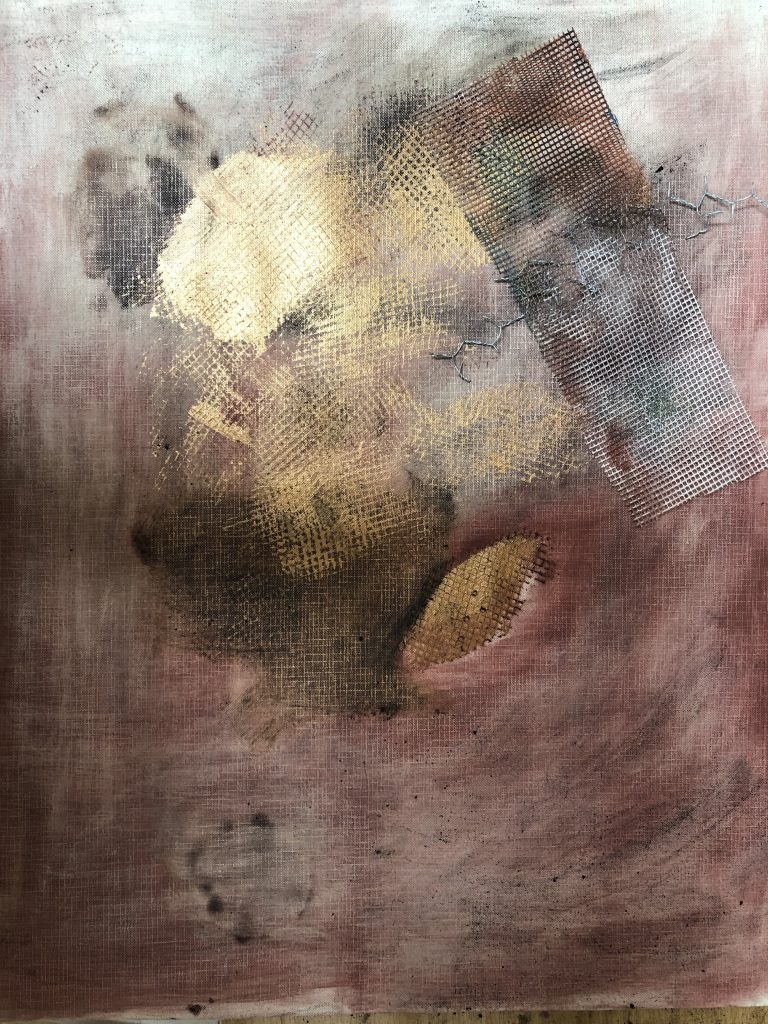
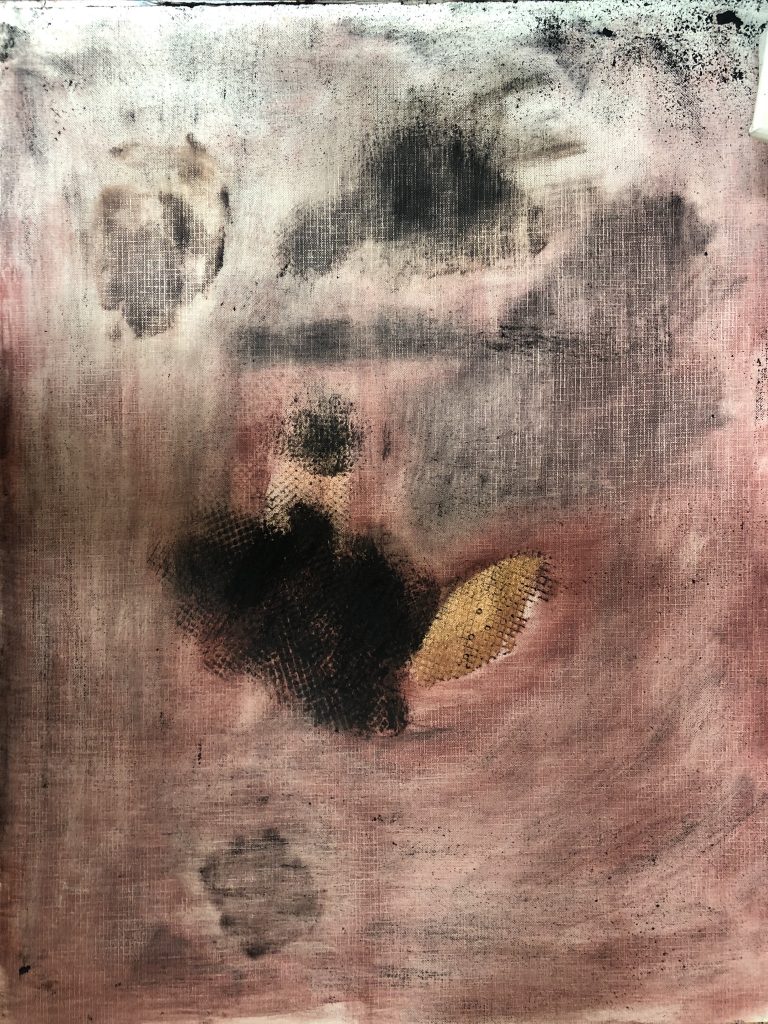


Reflecting on the work, but seeing it as work under investigation:
- the three golden objects remind of the Kalahari Truffels we find in our country and questions around making and connecting with the fungi world stays close by- i
- Is this work leading me to the connections between making and research?
- I love the objects showing their ‘ground’ /shadows in the work – it reminds of the sea side and found objects – the mycelium-like structure could also be a coral from the sea – found objects showing me about the relationship between things.
- This could be a drawing of found objects – but they are imaginary and using frothing and shadows and mark making it became objects related to the Fungal Kingdom.
- I am questioning the coral like drawing on top – I like it for its softness and idea of connectivity, but is this not too litererally?
–
Looking at the work of Emma Stibbons

This is a five-meter high installed, in parts, drawing, called ‘Wild Fire’. It depicts the aftermath of a forest fire. It is drawn in charcoal, partially recovered from a recent forest fire. This really monumental drawing includes 3D elements of salvaged burnt conifers. I can see how a drawing and 3d elements can really work very well. I understand from this work how space is separated and opened up by using a painting as well as installation. One gets the absolute feeling of devastation that a burnt fire leaves behind. It reminded me of the yearly veld fires, in winter, we have at our guesthouse in Krugersdorp, Johannesburg. I have many images of this raging fire in the eucalyptus trees and our efforts to cut down the trees which are seen as invaders in our country and can really pose a threat to the environment and all living in the area of a fire.
It reminds me of my collaboration in the Parallel Project -we are trying to bring my drawing together with Annettes-made fungi by using Photoshop. We are separated by living in different spaces – she in Europe and me here in Southern Africa. The work will be shown as a digital image on a digital platform.

Looking at the work of Ian Kiaer
I use the Tate online site to educate myself more about this artist. From my tutor’s advice I look at this work in terms of relationships between things, and try to understand how he thinks. Tone and colour is observed in his work – I presume it helps to keep different things/objects in a visual coherence, I also like the materials he work with as well as a type (certain?) viewpoint he takes when placing objects. Materials are foam, cardboard, painting, balsa wood. In away the different objects
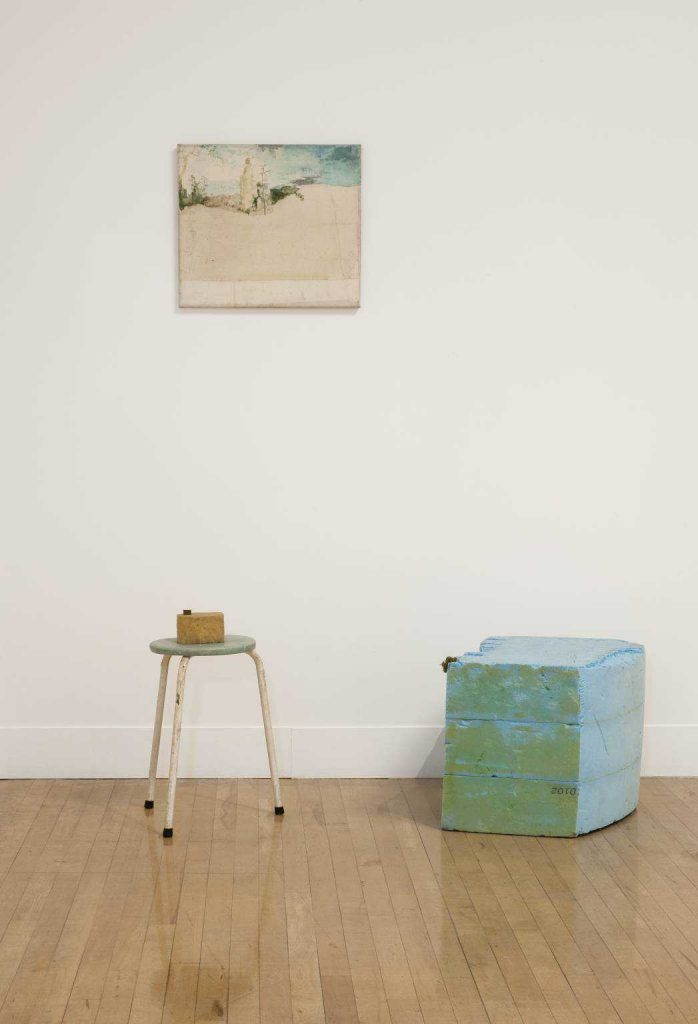
I understand in the above work, Kiaer links Brueghel with the Italian poet Curzio Malaparte, who was exiled by Mussolini in 1933. The work shows a large, chunk of blue foam, positioned next to a stool. On the stool is a smaller square of brown foam supporting a minute balsa wood house. On the wall hangs a canvas painted with an empty landscape. If one understands the landscape he is referring to one will understand that the small house is suggesting an isolated dwelling dwarfed by its surroundings, and the windmill in the painting draws from a Brueghel work as well as Malaparte living on this rock above the Tyrrhenian Sea due to being imprisoned for two and a half years of isolation. I love how the soft blue colours are seen in each separate object, and that foam could be used as a metaphor for rocks and the ocean. The little wooden house is reminiscent of a place of solace and being outside the normal world – hideout, a place to think, but here it is a place of forced exile. It does talk about remoteness – I think the fact the objects placed under the painting is in the work, makes it also remote from reality for a viewer.
I do like what I read in the work – If I take it to my personal aesthetic. I place things next to each other, for me they are the same or can go together, there is a type of connection. I also know that this placing is blurring the boundary between intentionality and chance, I would like to think that that is what I can achieve. I need to think about the way I associate things I am making during the making process. When looking at his materials I am intrigued by the fact that is it everyday things, even re-usable or recycled: The idea that one makes something from scratch is always false’, Kiaer says. ‘When making, you are involved in a conversation, you are taking up what someone else has already said and developing it. In this way, reuse can be a form of listening to what has been as well as what is.…. implicit critiques of the very notion of the ‘new’. ‘In one way’, says Kiaer, ‘all my work is a revision of ideas and things’. https://alisonjacques.com/artists/ian-kiaer)
In my work, I should find this conversation, instead of separating the works. It can create a certain type of theatricality to the work, which I do like. I also think it is a way to interrogate our environment and how we interact in it. Can I look at how we as humans experience the fungal kingdom or react to their environment? It seems after all this is about interacting, connecting – showing this in my work.
I do enjoy this work below, which is made with Acrylic, varnish, pencil and placed behind repurposed Plexigas. It is 150.5 x236cm in size.
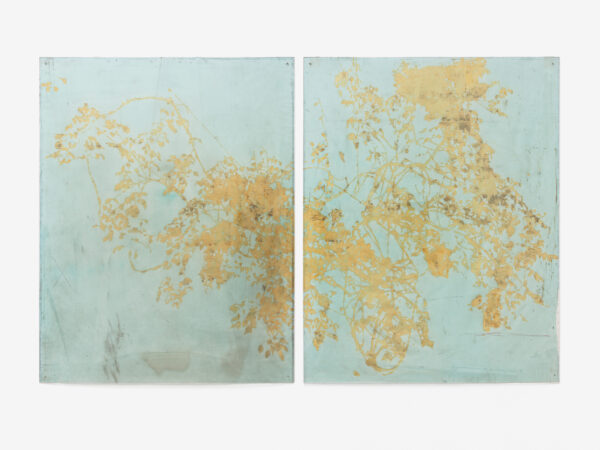
Looking at the work of Ben Woollfit